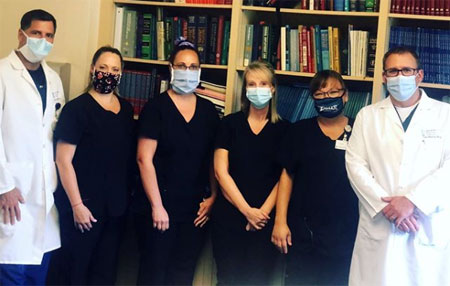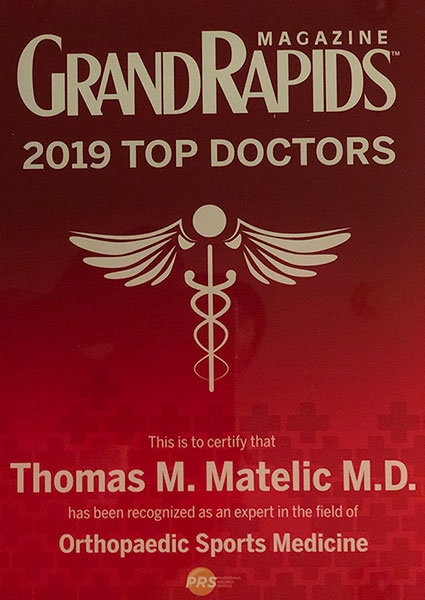Which is the Best Graft for ACL Reconstruction?
Overview
ACL Reconstruction, which is different than an ACL repair, requires removing your torn ACL and replacing it with transplanted tissue (called a graft) from somewhere else. There are two main sources for grafts – autograft and allograft.
Autograft requires taking tissue, usually a tendon from another location in your own body (termed harvesting) and moving it into the knee to replace the ACL.
Allograft, also called donor graft or cadaver graft, is tendon from someone who has donated their tissue.
Patients often ask, “what is the best ACL graft?” In general, each graft choice has benefits and side effects depending on the circumstances. There are pros and cons for each option and selection of the appropriate graft should be individualized to each patient.
Autograft
The main benefit of autograft is that we are using your own tissue to replace the ACL. Since it is your own tissue, it is recognized by your knee as your own tissue and cells, therefore it is incorporated more quickly into your body, and it has the safest healing potential and usually the best results. The shortcomings of autograft tissue include: longer surgery time, larger incisions, and more postoperative pain due to the trauma to the donor site of the tissue. There are also concerns about persistent postoperative weakness of the muscles where the tendon has been harvested from – this is termed “donor site morbidity.” Common harvest sites include the patellar tendon, hamstring tendon and quadriceps tendon.
Patellar Tendon
The patellar tendon is the tendon in front of your knee. It attaches from the knee cap to the shin bone. It is the graft with the longest track record and is considered by many to be the “gold-standard” for ACL reconstruction. Historically this is the graft often recommended in professional athletes and high risk individuals that are going to go back to cutting, jumping and twisting sports that place significant stress on the knee.
The surgery requires taking the central third of the tendon with a small piece of bone from the knee cap and a small piece of bone from the tibia (shinbone).
It is a strong graft with the most secure fixation, a low failure rate and a high rate of patient satisfaction.
The shortcomings of the graft are primarily related to donor site morbidity. The longer incision on the front of the knee may be cosmetically undesirable to some. There is usually some numbness in the front of the knee from harvesting the tendon. There is also an increased risk of pain in the front of the knee with sports and with kneeling. This option may not be great for those with occupations that require a lot of kneeling – , carpenter, plumber, etc. Quadriceps weakness after surgery is also expected and this may make post operative rehab more difficult..
Hamstring Tendon
Hamstring tendons, tendons located in the back of your thigh, are harvested through a small incision just below the knee.
The hamstring graft, like the patellar tendon, has an excellent track record with high patient satisfaction. It is also mechanically the strongest graft to failure. Since the incision is smaller it has a better cosmetic appearance and more importantly less pain in the front of the knee and less pain with kneeling. Hamstring grafts are a common graft used world wide and have had an excellent track record.
There are also risks of using of hamstring autograft. The time it takes for the ligament to heal into the bone and mature is likely greater than with patellar tendon autograft. There is also minor weakness of the hamstring musculature in the back of the thigh after surgery. Finally, there is some information that states that hamstring grafts have a slightly higher failure rate in young female athletes, which is most likely due to the smaller hamstring tendons and grafts in these individuals.
In general, a hamstring autograft is an excellent option for athletes with just a slightly higher failure rate with less morbidity than the patellar tendon graft. It is also a desirable option for those who are concerned about the cosmetic appearance of a larger incision on the front of the knee or when the incision can impact activities of daily living.
Quadriceps Tendon
Quadriceps tendon have been used for ligament reconstruction for years, but using the middle one-third quadriceps tendon as the choice for ACL reconstruction has had a resurgence recently using modern “all-inside” techniques. It has been studied less which makes it difficult to fully compare it with the other options. However, recent studies have shown comparable results when compared to patellar tendon autograft. Proponents have argued that the graft more naturally mimics the anterior cruciate ligament, and that the donor site morbidity is less than with patellar tendon autograft. When compared to patellar tendon autograft there is less numbness around the incision, and less kneeling pain. When compared with the hamstring tendon graft, the quadriceps graft is consistently larger and has a re-rupture rate similar to the patellar tendon graft. Potential risk factors for the quadriceps tendon graft include increased quadriceps muscle atrophy and quadriceps tendonitis and stiffness of the knee if the graft is too large.
Allograft
Allograft is tissue that has been donated, processed and sterilized and placed in secure packaging and kept protected until the time surgery.
Strengths
The strengths of allograft reconstruction include shorter surgery time, smaller incisions, easier postoperative recovery and no “donor site morbidity.” It is a very good option for individuals who participate in lower risks activities or in the older athletic population. There are multiple types and sizes of allografts that can be used which gives your surgeon significant flexibility. This is particularly useful in challenging cases when multiple ligaments need to be reconstructed or in revision ACL reconstruction.
Weaknesses
The weaknesses of allograft include the risk of slower healing of the foreign tissue (a process called incorporation). Due to this slower incorporation, there is an increased risk of graft failure compared to autograft, this is particular true in younger athletes. Multiple studies have shown a significant increase in graft failure in young patients (less than 30 years old) with allograft compared to autograft. The safety record for allograft tissue is excellent, however there is potential increased risk of infection compared to autograft reconstruction since the graft has to be obtained surgically in a sterile environment, processed, transported and stored in a safe and sterile manner. We are fortunate in the US to have excellent FDA approved tissue banks which make allograft surgery very safe.
Situations for Allograft ACL
Allograft tendons are frequently utilized in revision surgeries when a primary graft has failed, in knees with multi-ligament injuries – where it is impossible to obtain enough tissue to reconstruct the ligaments from the patient’s own body, and in individuals with lower demands.
Surgical Technique
While each graft has its advantages and disadvantages, a successful surgery and recovery depends more on surgical technique. There are five important aspects to ACL reconstruction surgery. First of all, the graft must be harvested correctly and it must be strong enough to substitute for your own native ACL. It must then be prepared so that it can be transplanted into your knee and fixed into position. The graft must be put in the correct anatomic location of your knee so that it can function like your ACL and restore the knees stability and proper mechanics. The graft then needs to be tensioned appropriately so as to have the correct stiffness and yet still allow knee mobility. Once the graft is placed in the correct location and tensioned adequately, it needs to be fixed into place rigidly to allow safe and early rehabilitation without harming the graft. Lastly, preoperative and postoperative physical therapy are important for the success of your surgery and recovery.
Summary
ACL reconstruction is a common surgery that is technically demanding and can be successful with different graft choices,. Various autograft and allograft tissue can be used with great results if the graft is personalized to the patient based on their goals and expectations. While the graft you use for reconstruction is something you should discuss with your surgeon, the ultimate result depends on surgical technique and a successful rehabilitation. Most sports medicine orthopaedic surgeons are comfortable using all graft options. You should be comfortable with your surgical decision and approach surgery with a positive attitude knowing that regardless of graft choice, you have a great chance to get back to your sport and active lifestyle.


 Thank you to my outstanding team that helped me get chosen by my peers to be one of “Grand Rapids Top Docs” by Grand Rapids Magazine. You are all such a dedicated and caring bunch of good peeps. (Including one PA not pictured) You know I couldn’t do it without y’all. #SportsMedicine is a Team Sport!
Thank you to my outstanding team that helped me get chosen by my peers to be one of “Grand Rapids Top Docs” by Grand Rapids Magazine. You are all such a dedicated and caring bunch of good peeps. (Including one PA not pictured) You know I couldn’t do it without y’all. #SportsMedicine is a Team Sport!

